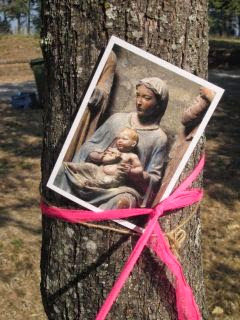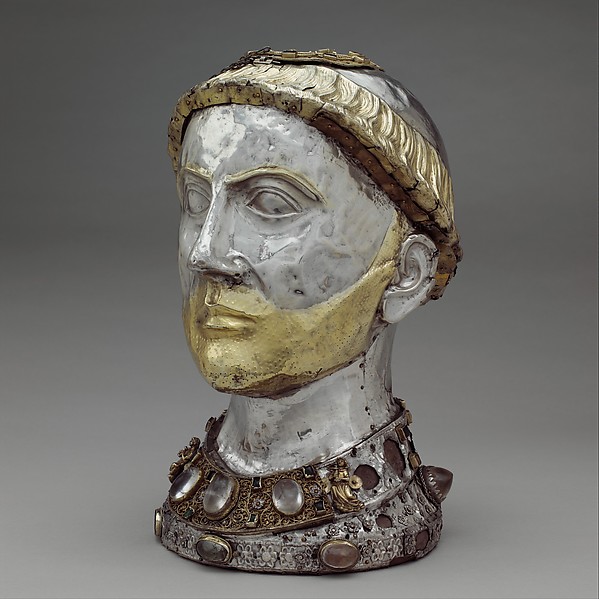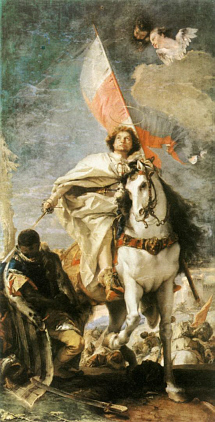St. Yrieix was a 6th century monk who founded the monastery
around which grew the town of St. Yeuix Lesperch.
around which grew the town of St. Yeuix Lesperch.
He was a blood relation to Clovis, (c. 466 – c. 511)
"the first king of what would eventually become France".
"the first king of what would eventually become France".
After
much persuasion from his wife, and a bit of political posturing, Clovis
converted from paganism to Catholicism, thus setting into motion the French allegiance to the church of Rome.
This is what I had believed to
St. Yeuix's medieval golden reliquary head,
protected behind glass in the church and waiting for its day out on the town.
But now, after some research, I'm discovering it isn't the real thing, it is only a replica. ****
"Does that matter?" I often ask myself when confronted
with the compromising aspects of modern life.
But I never have a good answer.
But now, after some research, I'm discovering it isn't the real thing, it is only a replica. ****
"Does that matter?" I often ask myself when confronted
with the compromising aspects of modern life.
But I never have a good answer.
A photo from a display in the church
The Ostensions is a traditional ceremony
particular to the Limousin for the veneration of reliquaries.
The reliquary heads of local saints are carried in a procession
through the streets before being returned to the church.
Inside the head will be a relic, generally a piece of bone,
but it could be a bit of textile, that belonged to the saint in their life time.
The Ostensions are over a thousand years old
and since the 16th century they have been held every seven years.
Charming young girls dressed up as angels in white gowns and wings accompany
the head of St. Yreix as it is paraded about the town on his feast day, 25th August.
the head of St. Yreix as it is paraded about the town on his feast day, 25th August.
The followers invoke his protection for the town against "le mal des ardents", the burning sickness.
**** after more research, I have discovered that the reliquary in St Yeuix Lesperch
is a 20th Century copy, but it does contain the actual skull of the saint.
And this, no doubt, is the genuine medieval head of the saint.
**** after more research, I have discovered that the reliquary in St Yeuix Lesperch
is a 20th Century copy, but it does contain the actual skull of the saint.
And this, no doubt, is the genuine medieval head of the saint.
Reliquary Bust of Saint Yrieix, second quarter of 13th century
France, Limousin, Church of Saint–Yrieix–la–Perche
Gilded silver, rock crystal, gems, glass, originally over walnut core with silver leaf and gesso on interior; Reliquary: 15 x 9 3/16 x 10 1/4 in. (38.1 x 23.4 x 26.1 cm); wooden core: 14 7/16 x 8 7/8 x 9 13/16 in. (36.6 x 22.5 x 24.9 cm)
Gift of J. Pierpont Morgan, 1917 (17.190.352a,b)
See complete record  .
.
 .
.
Saint Yrieix, whose skull was once contained in this reliquary, was the sixth-century founder of a monastery south of Limoges that still bears his name. A special veneration of reliquaries in the form of the heads of local saints developed in the Limousin region during the Middle Ages and continues to the present. On feast days, the image would have been carried in procession through the streets and then placed on the altar for the veneration of the faithful. Although carefully carved, the wooden core was not intended to be seen but to provide support for the precious silver sheathing.
http://books.google.co.uk/books?id=8eD1Noek1yYC&pg=PA177&lpg=PA177&dq=Reliquary+Bust+of+Saint+Yrieix,+second+quarter+of+13th+century+France,+Limousin,+Church+of+Saint%E2%80%93Yrieix%E2%80%93la%E2%80%93Perche&source=bl&ots=TfPJq96KTi&sig=4_IQbFZXr1x6fBPdClUu8vKxG64&hl=en&sa=X&ei=PtNvVM32NYTIPMKvgagH&ved=0CDAQ6AEwAg#v=onepage&q=Reliquary%20Bust%20of%20Saint%20Yrieix%2C%20second%20quarter%20of%2013th%20century%20France%2C%20Limousin%2C%20Church%20of%20Saint%E2%80%93Yrieix%E2%80%93la%E2%80%93Perche&f=false
This is the longest link I have ever seen, not that I actually "look" at links,
however, this might also be one of the most interesting links I have ever seen.
Well worth a visit for those who like this sort of thing.
A little procession of metre high plaster apostles lined up against the wall of a dim side chapel.
The feast day procession had come and gone three days earlier.
The church and town were virtually empty.
The fountain's flow was nearly exhausted.
The previous night I had stayed at a very neat and tidy campsite and spent the evening sitting on the wall outside the office, watching the spinning wheel go round on my ipad.
The promise of wifi delivering my emails and connecting me
The promise of wifi delivering my emails and connecting me
to the "real" world felt both important and a waste of my time.
Facebook alerts that somebody likes candy crush or posted up a new profile photo
made me ask the "Does this matter?" question again.
Facebook alerts that somebody likes candy crush or posted up a new profile photo
made me ask the "Does this matter?" question again.









_1446_52-1.jpg)





